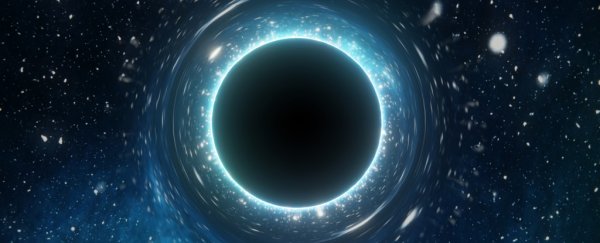The Universe is too heavy.
According to our measurements of the normal matter in the Universe, there's not nearly enough of it to account for the strength of the gravitational effects we can see.
Whatever is making up the rest of the mass is nothing we can detect directly, and the quest to figure out what it might be is both perplexing and consuming.
The placeholder term for this mysterious mass is ' dark matter', and there are multiple hypothetical candidates. A new paper, however, is making a fresh case for a candidate first proposed in the 1970s by Stephen Hawking and Bernard Carr – primordial black holes.
"Our study predicts how the early Universe would look if, instead of unknown particles, dark matter was made by black holes formed during the Big Bang – as Stephen Hawking suggested in the 1970s," says physicist Nico Cappelluti of the University of Miami.
"This would have several important implications. First, we would not need 'new physics' to explain dark matter. Moreover, this would help us to answer one of the most compelling questions of modern astrophysics: How could supermassive black holes in the early Universe have grown so big so fast?
"Given the mechanisms we observe today in the modern Universe, they would not have had enough time to form. This would also solve the long-standing mystery of why the mass of a galaxy is always proportional to the mass of the supermassive black hole in its center."
There are several reasons why black holes are not a leading candidate for dark matter. Nevertheless, they are an attractive one (pun absolutely intended); like dark matter, these ultradense objects emit no light, and, if they are hanging about in space not eating anything, they are very hard to detect; you can only do so by observing their gravitational effect on the surrounding space-time.
One of the problems physicists face is the sheer apparent quantity of dark matter. According to our calculations, just 15 percent of the matter in the Universe is made up of normal matter. The other 85 percent is dark matter.
That's extremely challenging to make up with black holes. According to our models, stellar-mass black holes form from massive stars, and there simply aren't enough massive stars out there to even come close to generating that number of black holes. Most of the Universe's stars are titchy red dwarfs.
Primordial black holes, however, are another matter, which is why, in recent years, they have seen something of a revival as a dark matter candidate. As the name suggests, these are black holes that could have formed from overdensities in the primordial plasma that filled the Universe immediately after the Big Bang.
These black holes could be the 'seeds' from which other black holes grew – but others could also have remained small enough to escape detection.
This explanation could also help explain some other conundrums, like how supermassive black holes – ones millions to billions of times the mass of the Sun – get so huge. At the moment, the question is a head-scratcher. According to the team's calculations, these behemoths could have grown in the early Universe by merging with other primordial black holes, and accreting nearby gas and stars.
"Primordial black holes, if they do exist, could well be the seeds from which all the supermassive black holes form, including the one at the center of the Milky Way," says astronomer and physicist Priyamvada Natarajan of Yale University.
"What I find personally super exciting about this idea is how it elegantly unifies the two really challenging problems that I work on – that of probing the nature of dark matter and the formation and growth of black holes – and resolves them in one fell swoop."
Primordial black holes could even help explain a mysterious excess of infrared radiation in the Universe. According to the team, growing primordial black holes would produce the same infrared signature.
While it would certainly be nice to solve so many mysteries in "one fell swoop", there are still some questions that would need answering.
For instance, distant light bends when it has traveled to us through the gravitational field of a black hole, and we simply haven't detected this happening nearly frequently enough to account for all the black holes that would constitute 85 percent of the matter in the Universe.
It's possible that we simply haven't conducted the right kinds of surveys. And this is what the team's paper set out to do: not prove that primordial black holes exist, but to lay out a case for their existence, so we can figure out what we need to look for.
With the James Webb Space Telescope – hopefully, fingers crossed – due to launch soon, we may be able to obtain some answers.
"If the first stars and galaxies already formed in the so-called 'dark ages', Webb should be able to see evidence of them," says astronomer Günther Hasinger of the European Space Agency.
The research has been accepted into The Astrophysical Journal, and is available on preprint server arXiv.
